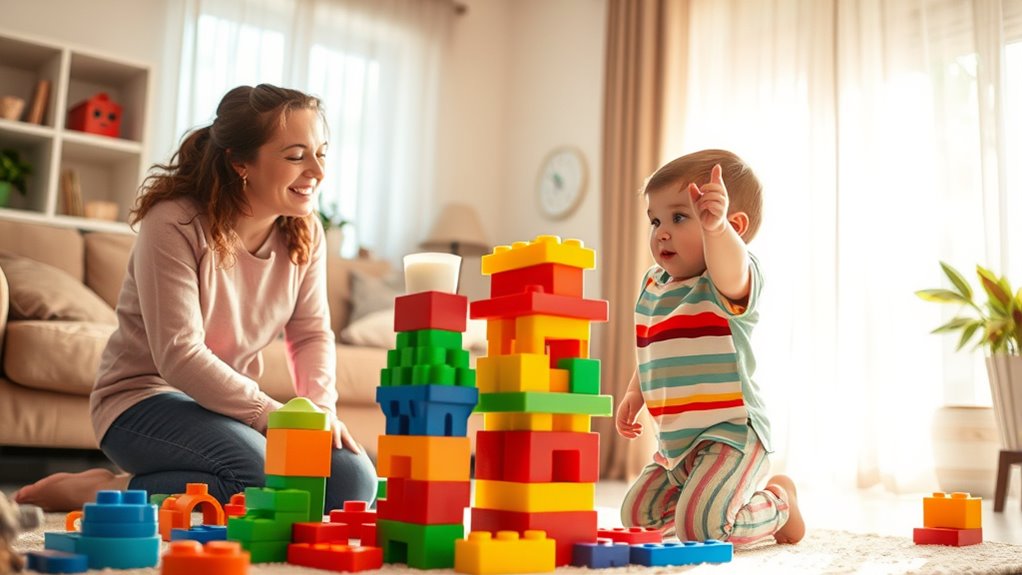As a parent, your role in child-led play is to create a safe, inviting environment that encourages independence and exploration. Show interest with open-ended questions, but avoid controlling or directing the play. Trust your child’s choices and give them space to experiment and make decisions. Your support fosters confidence, creativity, and resilience. To discover how you can effectively nurture your child’s autonomy and growth through play, keep exploring these helpful strategies.
Key Takeaways
- Show interest through open-ended questions and encouragement without directing or controlling play activities.
- Provide a variety of open-ended toys and materials to support child exploration.
- Respect children’s choices, even if play seems messy or unconventional, fostering independence.
- Maintain a supportive presence by observing and stepping back, allowing children to lead their play.
- Trust and support children’s instincts to promote confidence, resilience, and long-term development.

Child-led play is a powerful way for children to explore, learn, and develop essential skills, and your role as a parent is crucial in supporting this process. One of the most important aspects you can foster during play is child autonomy. When children are allowed to direct their activities, they gain confidence, independence, and a sense of control over their environment. Your job isn’t to dictate what they do or to constantly intervene; instead, it’s about creating a space where they feel safe to make their own choices. This means offering a variety of open-ended toys and materials that encourage creativity and problem-solving, rather than overly structured activities. By stepping back and observing, you give children the opportunity to lead their play and discover their interests, which builds their sense of autonomy.
Supporting child-led play fosters confidence, independence, and creativity by allowing children to make their own choices and explore freely.
Parental involvement doesn’t mean hovering or taking over; it’s about being present in a supportive, unobtrusive way. When your child initiates play, you can show interest by asking open-ended questions or offering encouragement, but you should avoid directing the activity. For example, if your child is building with blocks, instead of telling them how to do it, you might say, “That looks interesting. What are you building?” This kind of engagement shows that you value their ideas and decisions. Your involvement can also mean providing a safe environment where children feel free to experiment and take risks without fear of judgment or interruption. This balance allows children to develop resilience and problem-solving skills on their own.
Furthermore, facilitating child autonomy through your parental involvement means trusting your child’s instincts and respecting their choices. Sometimes, this might mean stepping back even if their play seems messy or unconventional. This trust signals that you believe in their ability to learn from their experiences. It’s also essential to be patient and give them space to explore at their own pace. When you support child autonomy in this way, you’re helping your child become a confident, self-reliant learner.
Additionally, understanding the importance of developmental stages can help you better support your child’s growth through play. Ultimately, your role is to be a quiet supporter rather than a director. By fostering child autonomy and practicing mindful parental involvement, you empower your child to take charge of their play. This not only nurtures their creativity and independence but also lays the foundation for healthy social and emotional development. When children feel trusted and supported, they’re more likely to develop a love for learning and a resilient attitude that will serve them well throughout life.
Frequently Asked Questions
How Can Parents Encourage Child-Led Play Without Dominating the Activity?
You can encourage child-led play by setting boundaries that give your child space to explore freely. Avoid taking control or directing the activity; instead, let them choose and decide how to play. Foster independence by providing open-ended materials and trusting their choices. Your role is to support and observe, stepping in only when needed, so they feel confident to lead their play while knowing boundaries are in place.
What Are Common Challenges Parents Face During Child-Led Play Sessions?
Imagine you’re steering a lively river, yet managing distractions and providing structure feels like steering through turbulent waters. You might find it challenging to stay focused as your child explores freely, and balancing guidance without taking over can be tricky. Common challenges include managing distractions that pull your attention away and offering enough structure to keep play meaningful. With patience and mindful involvement, you can gently steer, allowing your child’s creativity to flourish.
How Does Child-Led Play Impact a Child’s Social Skills Development?
Child-led play boosts your child’s social skills by encouraging peer interaction and emotional intelligence. As they navigate play scenarios, they learn to share, take turns, and understand others’ feelings. This active engagement helps them develop empathy and communication skills naturally. By observing and participating when appropriate, you support their growth, allowing them to build confidence and stronger relationships with peers, which are essential for their social development.
Are There Specific Toys or Materials That Facilitate Better Child-Led Play?
You’ll find that educational toys and open-ended materials truly enhance child-led play. These items encourage creativity, exploration, and problem-solving, giving your child the freedom to direct their activities. Look for versatile toys that can be used in multiple ways, like building blocks, art supplies, or dress-up clothes. By providing these materials, you support your child’s natural curiosity and help foster their independence and cognitive development.
How Can Parents Balance Guidance and Independence During Playtime?
You can balance guidance and independence during play by setting boundaries, fostering creativity, and observing your child’s cues. Offer gentle suggestions when needed, encourage exploration without interference, and respect their choices. By establishing clear limits while allowing freedom to experiment, you help nurture confidence and independence. Remember, the goal is to support their development, not control it, so stay attentive and adaptable to their evolving needs.
Conclusion
So, while you might think stepping back lets your child truly lead, don’t forget—you’re still the one shaping their world. Ironically, by doing less, you’re actually guiding more. Your quiet presence, after all, can be the biggest gift you give during playtime. So, next time you hesitate, remember: sometimes, the best way to lead is simply to follow—and watch them flourish while you enjoy the show. After all, you’re still in charge… just in a different way.











